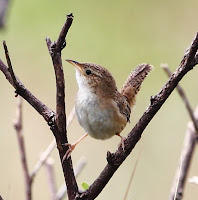SEDGE WREN
SEDGE WREN – (Cistothorus platensis) – (See images below)
DESCRIPTION: The Sedge Wren adult top parts are medium brown with beige streaks and bars. Under parts are light grey with chestnut flanks. Tail is often raised, even bent over body. Eyes are dark brown. Bill is brown on top, beige under. Legs and feet are grey. Sexes are similar. Juvenile head color is more uniform. Bird length is around 10 cm (4 inches). There are some 20 subspecies.
VOICE: https://www.xeno-canto.org/species/Cistothorus-stellaris
NAME: ‘Wren’ derives from Old English. ‘Sedge’ refers to the bird’s habitat. Latin genus name ‘Cistothorus’ means ‘running through shrubs’. Latin species name ‘platensis’ means ‘from Rio La Plata’, where the first specimen came from.
HABITAT: Damp meadows, marshes with sedges.
DIET: Insects for the most part.
NESTING: Nest is a woven ball of sedges and other marsh plants, located above ground, and with a side entrance. From four to seven white eggs are laid, incubated by female. Chicks fed by both parents.
DISTRIBUTION: Breeds in south-central Canada and north central USA. Winters in southeast USA and northwest Mexico. During migration can be found in the regions in-between.
Distribution Map: https://en.wikipedia.org/wiki/Sedge_wren – /media/File:Cistothorus_stellaris_map.sv
ON PEI: Does not breed on Prince Edward Island, sightings listed as ‘accidental’ so far. See note below on bird vagrancy.
CONSERVATION: Population stable, not currently at risk.
Vagrancy: In biology this means an animal going way outside its normal range. For birds, this can happen when there are storms and they get blown off course. On other times, the bird simply wanders in a different direction than usual. Here’s an article about vagrancy in birds.
SIMILAR SPECIES: Marsh Wren, Winter Wren
REFERENCES: https://www.borealbirds.org/bird/sedge-wren
https://www.audubon.org/field-guide/bird/sedge-wren
https://www.mba-aom.ca/jsp/toc.jsp (Maritimes Breeding Bird Atlas)
https://www.tn.gov/twra/wildlife/birds/sedge-wren.html (Tennessee Wildlife Resources Agency)
http://identify.whatbird.com/obj/695/overview/Sedge_Wren.aspx
https://guides.nynhp.org/sedge-wren/ (New York Natural Heritage Program)
http://fieldguide.mt.gov/speciesDetail.aspx?elcode=ABPBG10010 (Montana Field Guide)
https://animaldiversity.org/accounts/Cistothorus_platensis/ (University of Michigan)
https://txtbba.tamu.edu/species-accounts/sedge-wren/ (Texas Breeding Bird Atlas)
https://birdatlas.mb.ca/accounts/speciesaccount.jsp?sp=SEWR&lang=en (Manitoba Breeding Bird Atlas)
DESCRIPTION: The Sedge Wren adult top parts are medium brown with beige streaks and bars. Under parts are light grey with chestnut flanks. Tail is often raised, even bent over body. Eyes are dark brown. Bill is brown on top, beige under. Legs and feet are grey. Sexes are similar. Juvenile head color is more uniform. Bird length is around 10 cm (4 inches). There are some 20 subspecies.
VOICE: https://www.xeno-canto.org/species/Cistothorus-stellaris
NAME: ‘Wren’ derives from Old English. ‘Sedge’ refers to the bird’s habitat. Latin genus name ‘Cistothorus’ means ‘running through shrubs’. Latin species name ‘platensis’ means ‘from Rio La Plata’, where the first specimen came from.
HABITAT: Damp meadows, marshes with sedges.
DIET: Insects for the most part.
NESTING: Nest is a woven ball of sedges and other marsh plants, located above ground, and with a side entrance. From four to seven white eggs are laid, incubated by female. Chicks fed by both parents.
DISTRIBUTION: Breeds in south-central Canada and north central USA. Winters in southeast USA and northwest Mexico. During migration can be found in the regions in-between.
Distribution Map: https://en.wikipedia.org/wiki/Sedge_wren – /media/File:Cistothorus_stellaris_map.sv
ON PEI: Does not breed on Prince Edward Island, sightings listed as ‘accidental’ so far. See note below on bird vagrancy.
CONSERVATION: Population stable, not currently at risk.
Vagrancy: In biology this means an animal going way outside its normal range. For birds, this can happen when there are storms and they get blown off course. On other times, the bird simply wanders in a different direction than usual. Here’s an article about vagrancy in birds.
SIMILAR SPECIES: Marsh Wren, Winter Wren
REFERENCES: https://www.borealbirds.org/bird/sedge-wren
https://www.audubon.org/field-guide/bird/sedge-wren
https://www.mba-aom.ca/jsp/toc.jsp (Maritimes Breeding Bird Atlas)
https://www.tn.gov/twra/wildlife/birds/sedge-wren.html (Tennessee Wildlife Resources Agency)
http://identify.whatbird.com/obj/695/overview/Sedge_Wren.aspx
https://guides.nynhp.org/sedge-wren/ (New York Natural Heritage Program)
http://fieldguide.mt.gov/speciesDetail.aspx?elcode=ABPBG10010 (Montana Field Guide)
https://animaldiversity.org/accounts/Cistothorus_platensis/ (University of Michigan)
https://txtbba.tamu.edu/species-accounts/sedge-wren/ (Texas Breeding Bird Atlas)
https://birdatlas.mb.ca/accounts/speciesaccount.jsp?sp=SEWR&lang=en (Manitoba Breeding Bird Atlas)
 |
| Sedge wren, Colombia, Francesco Veronesi |
 |
| Sedge wren, Brasil, by Hector Bottai |